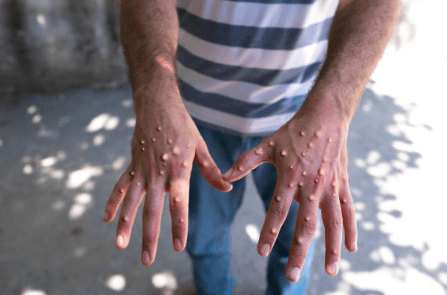Understanding Mpox: A Persistent Global Health Threat

Mpox, formerly known as monkeypox, continues to pose a global health challenge, with ongoing outbreaks and an upsurge of cases in various regions. This viral illness, characterized by a distinctive rash and flu-like symptoms, requires a clear understanding of its transmission, symptoms, and prevention, as consistently emphasized by the World Health Organization (WHO).
What is mpox?
Mpox is an infectious disease stemming from the monkeypox virus (MPXV), a member of the Orthopoxvirus genus, which also includes the variola virus (smallpox). According to the World Health Organization (WHO), there are two distinct clades of the virus: clade I (with subclades Ia and Ib) and clade II (with subclades IIa and IIb). The global outbreak seen in 2022–2023 was caused by the clade IIb strain.
While many people fully recover from mpox, some can experience severe illness, with children, pregnant individuals, and those with weakened immune systems (including uncontrolled HIV) being at higher risk for complications and even death, the WHO notes.
Symptoms and progression
Symptoms typically emerge within 1 to 21 days after exposure and usually last for 2 to 4 weeks. Common signs, as outlined by the WHO, include:
- Skin rash or mucosal lesions (which can be itchy or painful)
- Fever
- Headache
- Muscle aches and back pain
- Low energy
- Swollen lymph nodes
The rash often starts on the face and spreads across the body, including the palms and soles. It can also appear on contact points like the genitals. Lesions evolve from flat sores to liquid-filled blisters, eventually drying up, crusting over, and falling off. Individuals are considered infectious until all sores have healed and a new layer of skin has formed.
Complications can range from bacterial skin infections, pneumonia, and corneal infections leading to vision loss, to more severe conditions like infections of the blood (sepsis), brain (encephalitis), or heart (myocarditis), according to WHO data.
How mpox spreads
Mpox spreads from person to person mainly through close contact with an infected individual. The WHO details various transmission routes, including:
- Skin-to-skin contact: Such as touching or sexual contact.
- Mouth-to-mouth or mouth-to-skin contact: Including kissing.
- Face-to-face contact: Close talking or breathing that generates infectious respiratory particles.
- Contaminated materials: Contact with objects like clothing or linen used by an infected person.
- Animal-to-human transmission: Occurs from bites or scratches from infected animals, or through activities like hunting, skinning, or consuming infected animals. The natural animal reservoir for the virus is still unknown, the WHO states.
- Mother-to-child transmission: During pregnancy or birth, the virus can be passed to the fetus or newborn, potentially leading to pregnancy loss, stillbirth, or severe complications, according to the WHO.
The WHO notes that more research is needed to fully understand mpox transmission dynamics in various settings. Individuals with multiple sexual partners are identified by the organization as being at a higher risk of acquiring mpox.
Diagnosis, treatment, and prevention
Diagnosing mpox can be challenging due to symptoms resembling other conditions like chickenpox, measles, or sexually transmitted infections. The preferred diagnostic test is viral DNA detection by polymerase chain reaction (PCR), ideally from rash specimens (skin, fluid, or crusts), as per WHO guidelines.
While there is no specific proven antiviral treatment for mpox, supportive care is crucial. This includes managing pain and fever, ensuring proper nutrition and hydration, maintaining skin care, and preventing secondary infections. Antivirals are being evaluated in clinical trials, and some have received emergency use authorization in certain countries, the WHO indicates.
Vaccines for mpox are available and are considered an important public health intervention. The WHO recommends vaccination for high-risk groups, including:
- Health and care workers exposed to the virus.
- Household members and close contacts of someone with mpox.
- Individuals who have multiple sex partners, including men who have sex with men.
- Sex workers of any gender and their clients.
The vaccine can also be administered after exposure (post-exposure prophylaxis), ideally within four days of contact, or up to 14 days if symptoms have not developed, the WHO advises.
Self-care and preventing further spread
Most people recover from mpox within 2 to 4 weeks. The WHO provides guidance for individuals with mpox to help manage symptoms and prevent transmission:
- Contact a healthcare provider for advice.
- Isolate at home in a well-ventilated room if possible.
- Practice frequent hand hygiene.
- Wear a mask and cover lesions when around others until the rash heals.
- Avoid scratching sores to prevent spread and infection.
- Disinfect shared spaces frequently.
- Use over-the-counter pain medications for symptom relief.
To prevent transmission, infected individuals should isolate until all sores have healed and a new skin layer has formed. Using condoms during sex can reduce risk but does not prevent skin-to-skin spread, the WHO notes. Those exposed to mpox should monitor for symptoms for 21 days and avoid sexual activity during this period. Healthcare workers are advised by the WHO to use appropriate personal protective equipment (PPE) when caring for mpox patients.













![[Balik Eskwela 2025] DepEd releases revised basic education enrollment policy for SY 2025-2026](https://asiabiznetwork.com/wp-content/uploads/2025/06/viber_image_2025-06-14_18-53-06-141-870x570.jpg)